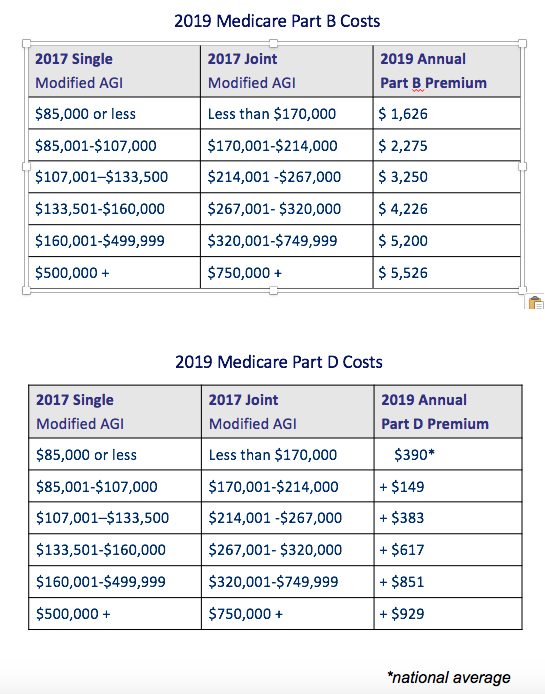Be a Hero
Looking back at 2018, one of the most popular and widely utilized ideas I discussed involves helping clients reduce their Medicare Premiums when transitioning to retirement. While speaking to consumers at client symposiums, I introduce them to IRMAA (pronounced Ehrma). It is not a pleasant introduction, as IRMAA stands for Income Related Monthly Adjustment Amount and is basically a tax on Medicare Parts B and D premiums. Those with higher incomes pay higher premiums. The charts below provide the 2019 income levels and corresponding premiums.

Since Medicare B and often Medicare D premiums are taken directly from one’s Social Security benefit, landing in a higher income bracket creates a tangible reduction in one of the primary sources of retirement income.
One important fact with an IRMAA is Social Security/Medicare use income from two years prior to determine current Medicare Premiums. For example, 2019 Medicare premiums are based on 2017 income.
As individuals digest this information, recent retirees will realize that two years ago they were often at the peak of their career, generating a robust income. This picture often changes with retirement and a corresponding drop in income. The premium determined by income levels two years prior will create a much higher premium compared to the premium that would be created by a current retiree income level. The logical question which follows is whether the Social Security Administration, who calculates the number and provides it to Medicare, will recognize this fact and lower the Medicare Parts B and D IRMAA.
The good news is they usually will. Your clients must, however, request them to do so. To make this request, clients must file form SSA-44 (with the Social Security Office). A quick look at the form reveals the most common, acceptable “life changing events”:
- Work Stoppage
- Work Reduction
- Marriage
- Divorce
- Death of a Spouse
Documentation will be required to validate both the life changing event as well as the income level. The goal is to lower Medicare Parts B and D premiums by having the premiums based on a current, lower income amount. The change can even be retroactive. It is prudent to file the form and follow up. The Social Security Administration is not obligated to respond to your clients’ request. The squeaky wheel often gets greased.
As we move into 2019, contact those clients in your practice who are transitioning into retirement and onto Medicare. Value added information on SSA-44 will make them a client for life.
The information in this presentation is provided as a general overview. It is derived from the Internal Revenue Code, Medicare.gov and other government publications, all subject matter sources reasonably believed to be reliable. Tax law and the laws governing Medicare/Medicaid are complex and subject to change. Clients should consult with their attorney and/or qualified tax advisor when making decisions regarding these matters.
One Comment
John Galloway
Very much enjoyed your webinar that you provided thru Lincoln. I would like to get a copy of the slides if possible. You mentioned the possible use of your tools on an advisor’s website. What would the details be on that.